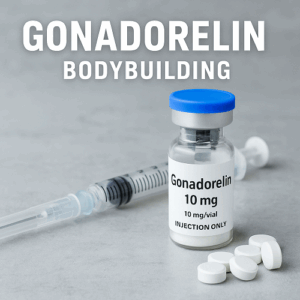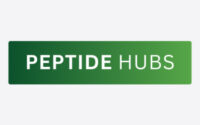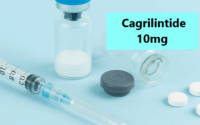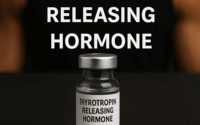Gonadorelin Bodybuilding
 Gonadorelin in Bodybuilding: The Role of GnRH in Hormonal Recovery and Performance
Gonadorelin in Bodybuilding: The Role of GnRH in Hormonal Recovery and Performance
Introduction
In the world of bodybuilding and performance enhancement, managing hormonal health is just as crucial as optimizing training, nutrition, and recovery. While anabolic steroids can build mass and strength rapidly, they often come with a cost: suppression of the body’s natural testosterone production. This is where compounds like Gonadorelin enter the picture.
Gonadorelin, also known as GnRH (Gonadotropin-Releasing Hormone), is a peptide-based compound that stimulates the natural production of LH (Luteinizing Hormone) and FSH (Follicle-Stimulating Hormone)—the very hormones responsible for testosterone production and fertility. In recent years, Gonadorelin has gained attention in the bodybuilding world for its role in post cycle therapy (PCT) and testosterone recovery.
This article explores how Gonadorelin works, its benefits in bodybuilding, optimal usage protocols, and safety considerations for athletes looking to protect or restore their hormonal health.
What Is Gonadorelin?
Gonadorelin is a synthetic version of the natural Gonadotropin-Releasing Hormone (GnRH) produced by the hypothalamus. It acts on the pituitary gland to trigger the release of LH and FSH—key players in regulating the production of testosterone and sperm in men.
In clinical settings, it’s used to assess pituitary function, treat hypogonadism, and support fertility. In bodybuilding, its off-label application is more targeted: kickstarting natural testosterone production, particularly after a steroid cycle or during long-term testosterone replacement therapy (TRT).
How Gonadorelin Works for Bodybuilders
During a cycle of anabolic steroids or testosterone, the body reduces its own natural production of GnRH, LH, and FSH through a negative feedback loop. As a result, testicular function may diminish—a condition known as hypogonadotropic hypogonadism.
Gonadorelin works by:
-
Mimicking natural GnRH
-
Stimulating the pituitary gland
-
Prompting a surge in LH and FSH
-
Leading to reactivation of testicular testosterone production
Unlike hCG, which directly stimulates the testes and may cause desensitization over time, Gonadorelin restores the full hormonal axis from the hypothalamus downward, making it a more “natural” reboot method.
Benefits of Gonadorelin for Bodybuilders and Athletes
✅ Supports Post Cycle Therapy (PCT)
Gonadorelin helps restore hormonal balance after a steroid cycle by stimulating the hypothalamic-pituitary-gonadal (HPG) axis—critical for long-term testosterone health and fertility.
✅ Prevents Testicular Atrophy
By reactivating LH and FSH production, Gonadorelin encourages the testes to maintain size and function, even during long-term suppression or TRT.
✅ Enhances Natural Testosterone Output
Used correctly, it helps athletes restart natural testosterone production more effectively than passive waiting or using only SERMs (like Nolvadex or Clomid).
✅ Improves Fertility Parameters
Gonadorelin can help restore sperm count and motility, making it relevant for athletes considering future fertility after long-term anabolic use.
✅ Short-Acting and Flexible
Its short half-life allows precise control over dosing and timing, reducing the risk of overstimulation or hormonal imbalances.
Gonadorelin Dosage and Cycle Protocols
⚠️ This information is for educational purposes only. Always consult a physician or endocrinologist before using peptide-based therapies.
Common Gonadorelin Dosage:
-
100–250 mcg per injection
-
Administered 1–3 times per day
-
Subcutaneous (belly fat) or intramuscular injection
Example Post-Cycle Therapy Protocol:
-
Days 1–14: 100 mcg, 2–3x daily
-
Combine with: Nolvadex (20 mg/day) or Clomid (25–50 mg/day)
-
Cycle Duration: 2–3 weeks, depending on recovery progress
On TRT or Long Cycles:
-
Use 100 mcg every other day to maintain testicular activity
-
Pair with periodic bloodwork to monitor LH, FSH, and total testosterone levels
Gonadorelin vs. hCG: Which Is Better?
| Feature | Gonadorelin | hCG (Human Chorionic Gonadotropin) |
|---|---|---|
| Mechanism | Stimulates GnRH → LH/FSH | Directly mimics LH |
| HPG Axis Recovery | Full axis activation | Partial (testes only) |
| Risk of Desensitization | Low | Moderate to high (with prolonged use) |
| Cycle Flexibility | High (short half-life) | Moderate |
| Ideal Use | PCT or HPTA restoration | In-cycle testicular maintenance |
Conclusion: Gonadorelin is better suited for restoring natural testosterone production, while hCG is better for preventing shutdown during ongoing suppression.
Side Effects and Considerations
While Gonadorelin is generally well-tolerated, improper use or overdosing can lead to:
Potential Side Effects:
-
Headaches or dizziness
-
Flushing or sweating
-
Mood fluctuations (from hormonal shifts)
-
Transient increases in cortisol or prolactin
-
Fatigue (usually resolves after dose adjustments)
Important: Due to its pulsatile nature, over-frequent dosing may blunt the pituitary’s responsiveness. Using conservative, timed doses is essential for efficacy and safety.
Is Gonadorelin Legal?
Gonadorelin is legal for research and medical purposes in most countries but is not approved for over-the-counter sale. It is not currently listed as a banned substance by WADA, but any use in professional sports should be disclosed and vetted.
For recreational bodybuilders or non-tested athletes, Gonadorelin is available through research chemical suppliers, though quality assurance and medical oversight are crucial.
Final Thoughts
Gonadorelin offers bodybuilders and athletes a powerful yet nuanced approach to testosterone restoration and hormonal recovery. As a GnRH analog, it goes beyond surface-level stimulation and addresses the root of hormonal shutdown by targeting the entire HPG axis.
Whether you’re coming off a heavy cycle, bridging between phases, or looking to safeguard long-term endocrine health, understanding Gonadorelin dosage and strategy can help you optimize performance and protect your body’s natural equilibrium.
As always, peptide use should be part of a well-structured plan, supported by bloodwork, expert guidance, and a commitment to long-term wellness.


